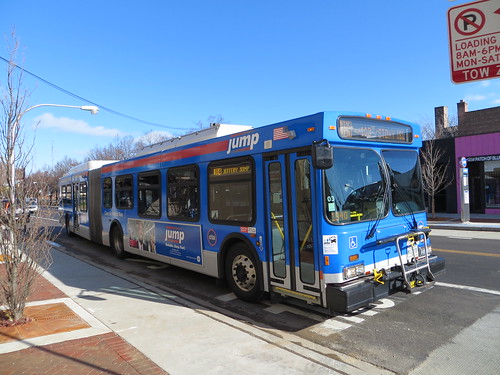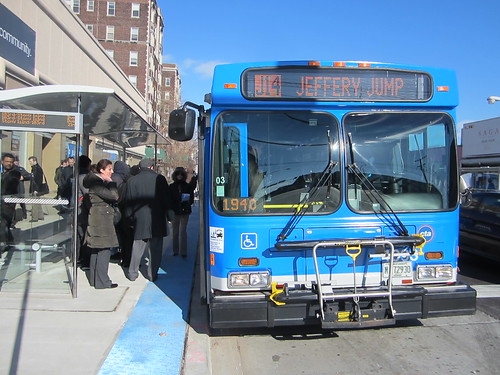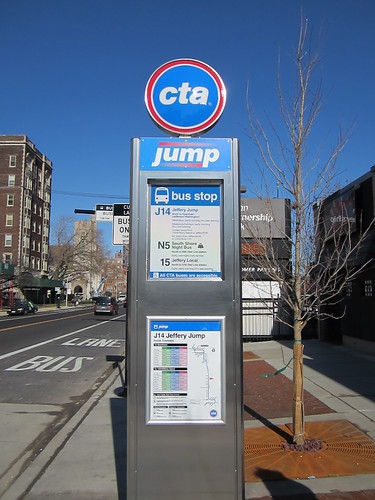Editor’s note: Last November the J14 Jeffery Jump bus launched as the CTA’s first attempt at creating an express bus service with some of the elements of bus rapid transit. While the 15 Jeffery Local makes 37 stops between 103rd Street and Lake Shore Drive, the Jump only makes 19 stops. Between 83rd and 67th streets, inbound buses travel in a dedicated lane during the morning rush hour and vice versa for the evening rush. This year the city will install a “queue jump” at 83rd Street, allowing buses to cut to the front of the line of stopped cars, and the stretch from 83rd to 73rd streets will get bus-priority stoplights, expediting transit trips.
A few weeks after the launch John Greenfield rode the entire 16-mile route from south to north during the morning rush hour and found that Jump service operated fairly efficiently. The were almost no unauthorized vehicles parking or driving in the bus lane, the express bus had no problem passing stopped local buses, and the whole trip took exactly one hour. To see if the service is still running smoothly, we recently asked James Porter, a journalist, musician, DJ and veteran CTA navigator, to ride the Jump route from north to south during the evening rush and report on its performance.
The CTA has been promoting their new Jeffery Jump route like it was the greatest invention short of the paperclip. As a South Side resident who has long used the regular Jeffery bus, I have been wondering what makes this new offshoot so miraculous. To find out, I rode the entire Jeffery Jump line on a weekday evening in March, and here's what I experienced:
4:59 p.m. Six people, including myself, board the bus at the north end of the line at Jefferson and Washington. This being Chicago, a sudden late-winter snowstorm has caught us all by surprise. The bus heads east on Washington and then south on Clinton. That day all the newspapers covered the tragic story of six-month-old Jonylah Watkins who was shot and killed while her father was changing her diapers in a minivan. As we’re rolling, one of our fellow riders feels the need to tell everybody within earshot about it, as if he were the first to break the news. This unofficial town crier continues his commentary speaking to everyone in general and no one in particular.
5:03 p.m. As the Jump heads east on Monroe, stopping to pick up passengers every two blocks, the sun finally makes an appearance, remaining in the sky for the balance of the afternoon. The bus slowly fills up with the rush hour crowd. After we cross the Chicago River into the Loop, the town crier pats his seat motioning for a middle-aged lady to sit. The seat remains empty. The streets are now damp from that impromptu snowstorm. As we cross LaSalle the town crier gallantly offers the seat next to him to various female standees. By this point, the bus is crowded. Although there are three empty seats left, for some reason everyone chooses to stand.
5:12 p.m. At State Street the Jump empties out a little as riders depart for the Red Line, freeing up yet more seats. We turn south on Michigan and, strangely enough, the automated voice that calls out the stops, which has been silent for most of the ride so far, suddenly becomes audible again at Van Buren. The bus has been moving efficiently, with no noticeable delays. We’re making good time so far.
5:28 p.m. The Jump heads east on Balbo, whizzing past a group of diehards playing touch football in Grant Park. It’s nice to see that the fickle weather hasn't deterred them. We turn south on Columbus and then enter Lake Shore Drive at Roosevelt, beginning the scenic, nonstop journey down the Lake Michigan shoreline, past the Museum of Science & Industry, until we get to the South Shore neighborhood.
5:42 p.m. At 67th Street the driver turns into Jeffery Boulevard. Up to this point, the clientele has been primarily adults, with hardly anyone on the bus under the age of 18. This soon changes at Jeffery, when a couple of young teens sneak on the bus through the back door. As we roll south, the dedicated bus lane is free of parked vehicles. We’re moving at about the same speed as the car traffic in the next lane, which is flowing smoothly. At 71st Street I see the snazzy, stainless steel “Commercial Showcase Station” bus shelters with LED arrival time screens, as well as the nine-foot-tall info kiosks with a map of the route. I’ll see several more of these kiosks along the rest of the route.
5:50 p.m. The Jump is still moving efficiently and isn’t having any problems getting stuck behind Jeffery Local buses. We whiz past Herbert's Hair Manor, 7854 South Jeffery, with its funky window sign proclaiming "NO SMOKIN' IN THE BARBER (SHOP) OR ANY KIND OF SMOKIN'." We continue under the viaduct at 84th, under the Chicago Skyway. The next few blocks are mostly industrial; the few signs of life include a church, a Jiffy Lube and several fast-food joints. By 87th there are only a handful of riders left.
6:00 p.m. At 100th the bus turns east, rolling through the residential South Deering neighborhood. We head south on Torrence, then west again on 103rd. By now, the Loop skyscrapers seem like a distant memory. This section of the Far South Side feels almost rural, as trees and freight trains fly by my window.
6:08 p.m. The bus arrives at the 103rd Street & Stony Island garage terminal. My entire Jeffery Jump trip has taken one hour and nine minutes, which is nine minutes longer than the northbound trip John Greenfield took last fall. It seems to me that the J.J. line runs quite efficiently, although it appears to be basically the same as the old Jeffery Express bus with a facelift, plus the dedicated bus lanes. But John tells me that some improvements are on the way this year in terms of bus-friendly traffic signals. Hopefully those will make the Jump run faster than ever in the future.







